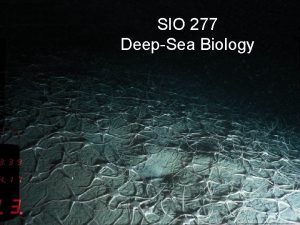DeepSea Creatures Photos Adaptation is the name of









- Slides: 9

Deep-Sea Creatures Photos Adaptation is the name of the game when you live thousands of feet below the water’s surface. See how these deep-sea denizens make the most of their deep, dark home. https: //www. nationalgeographic. com/environment/oceans/ph otos/deep-sea-creatures/

FRILLED SHARK Humans rarely encounter frilled sharks, which prefer to remain in the oceans' depths, up to 1, 500 meters below the surface. Considered living fossils, frilled sharks bear many physical characteristics of ancestors who swam the seas in the time of the dinosaurs.

GIANT SPIDER CRAB Thought to be the largest arthropods on Earth, giant spider crabs spend their time foraging on the ocean floor up to a 300 meters deep. These rare, leggy behemoths, native to the waters off Japan, can measure up to 3. 7 meters from claw tip to claw tip. This 1. 5 -meter specimen was photographed in Japan's Sagami Bay.

ATLANTIC WOLFFISH PAIR The sinister-looking Atlantic wolffish makes its home in the rocky coastal depths up to 500 meters below. Reaching 1. 5 meters long, wolffish have conspicuous dentition suited to a diet of hard-shelled mollusks, crabs, and sea urchins. This mated pair was found in a deep-sea den off the coast of Maine.

FANGTOOTH FISH The nightmarish fangtooth is among the deepest-living fish ever discovered. The fish's normal habitat ranges as high as about 2, 000 meters, but it has been found swimming at icy, crushing depths near 5, 000 meters. Fangtooth fish reach only about 16 centimeters long, but their namesake teeth are the largest, proportionate to body size, of any fish.

Six-gill sharks, like this one off the coast of Vancouver, cruise the ocean floor during the day, sometimes as deep as 2, 500 meters, then move toward the surface at night to feed. They can reach impressive lengths of 4. 8 meters on a diet of other sharks, rays, squids, crabs, and occasionally seals.

GIANT TUBE WORMS Crushing pressure, freezing temperatures, and zero sunlight isn't enough of a challenge for giant tube worms. They've adapted to thrive at the edge of hydrothermal vents, which spew superheated water saturated with toxic chemicals. This colony was photographed 1. 5 miles (2. 4 kilometers) below the ocean's surface on the East Pacific Rise near the Galápagos Islands.

VAMPIRE SQUID Vampire squid is an apt name for a creature that lurks in the lightless depths of the ocean. Comfortable at 3, 000 meters below the surface, these diminutive cephalopods navigate the blackness with eyes that are proportionately the largest of any animal on Earth. The species gets its name from its dark, webbed arms, which it can draw over itself like a cloak. It occupies the mesopelagic and bathypelagic regions of temperate and tropical world oceans.

PACIFIC VIPERFISH The Pacific viperfish has jagged, needlelike teeth so outsized it can't close its mouth. These deep-sea demons reach only about 25 centimeters long. They troll the depths up to 4, 400 meters below, luring prey with bioluminescent photophores on their bellies.
















